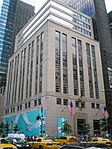LVMH Tower
1999 establishments in New York CityLVMHMadison AvenueMidtown ManhattanOffice buildings completed in 1999 ... and 3 more
Skyscraper office buildings in ManhattanSkyscrapers on 57th Street (Manhattan)Use mdy dates from August 2019

The LVMH Tower is a 24-story skyscraper on 57th Street, near Madison Avenue, in the Midtown Manhattan neighborhood of New York City. Designed by Christian de Portzamparc, the building opened in 1999 as the United States headquarters of LVMH Moët Hennessy Louis Vuitton SE. The building has received widespread praise from architecture critics.
Excerpt from the Wikipedia article LVMH Tower (License: CC BY-SA 3.0, Authors, Images).LVMH Tower
East 57th Street, New York Manhattan
Geographical coordinates (GPS) Address External links Nearby Places Show on map
Geographical coordinates (GPS)
| Latitude | Longitude |
|---|---|
| N 40.762683333333 ° | E -73.972652777778 ° |
Address
LVMH Tower
East 57th Street 19
10022 New York, Manhattan
New York, United States
Open on Google Maps







